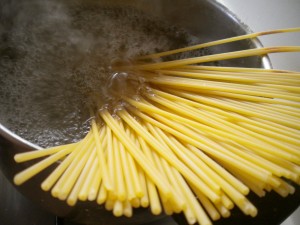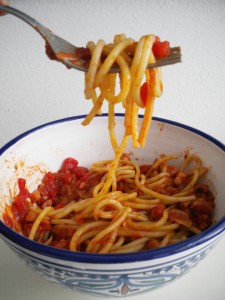 Pasta is my staple. Plain pasta with just a little olive oil, or butter, maybe white pepper and herbs from the garden, even with a store-bought sauce straight out of the jar, is so satisfying and easy that I have to find something pretty good (and pretty easy) to justify cooking anything else.
Pasta is my staple. Plain pasta with just a little olive oil, or butter, maybe white pepper and herbs from the garden, even with a store-bought sauce straight out of the jar, is so satisfying and easy that I have to find something pretty good (and pretty easy) to justify cooking anything else.
The National Pasta Museum of Italy, the most delightfully tourist-trappy museum in all Rome, is a propaganda factory dedicated to convincing visitors that pasta is the perfect food, was invented in Italy rather than being based on Marco Polo’s experiences in China (wrong!), and that it can single-highhandedly end world hunger. There is, however, some substance to their motto, “if flour is silver, semolina is gold.” Real semolina flour tastes much better than ordinary wheat, and is much higher in protein – in fact it has as much protein per ounce as chicken breast. The quality of a pasta is thus dependent on the quality of the semolina used. While all pasta is good, if you’re used to common store brands, try an imported Italian brand once or twice and you can tell the difference. Is it always worth seeking out imported pasta? In my opinion no, but it is when you’re doing something delicate. If you’re eating pasta with just herbs and oil to maximize the flavor of a new crop of spicy Thai basil blossoms, for example, then go for the good noodles; for a red sauce, you won’t notice so much, so better to save the fifty cents. Always remember, though, that better pasta made with better semolina retains its firm “al dente” texture longer, so if you often accidentally wait too long to take it out of the water, using better quality noodles will avoid mush.
Comments on preparing pasta:
- I always put salt in the water, but only sometimes olive oil. Olive oil is necessary when cooking a lot of pasta at once in a cramped pot, or when preparing something which clumps easily. Always add olive oil to the water when cooking angel hair – you’ll be glad you did.

Comments on individual unusual noodles:
- Bucatini: looks like extremely fat spaghetti, but actually has a hole down the middle, making it an extremely long narrow tube, almost like a straw. It’s a regional noodle from Lazio (the area around Rome), and is most often served with Amatriciana, a rich tomato sauce with bacon and onion. Bucatini is extremely floppy and unmanageable, and a good bowl of Bucatini all’ Amatricia is guaranteed to spatter red all over everything.
- Strozzapreti: A Tuscan pasta whose name means “priest-choker”. Hand-rolled, people talk about how Strozzapreti look like long curly twists, but honestly, especially when they’re covered in sauce, they look more like what a five-year-old would produce if you gave them playdough and asked them to make noodles… or slugs. Strozzapreti is a rustic pasta and I like it best with rustic, dark, mushroom based sauces, like wild mushroom cream sauce, or porcini mushroom sauce, but it’s also often baked with cheese.


